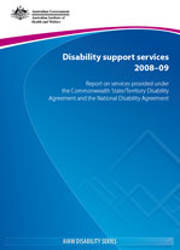PDF table of contents
Preliminary material: Acknowledgments; Abbreviations; Symbols
Summary
- Increase in service users and expenditure
- More service providers
- Service user characteristics
-
Introduction
- Terminology
- Changes from previous data collections
- Changes to the report format
-
About disability support services
- 2.1 Providers of disability support services
- 2.2 Number of services provided and service users
- 2.3 Need for services
- 2.4 Government expenditure on disability support services
-
Who uses disability support services?
- 3.1 Overview
- 3.2 Aboriginal and Torres Strait Islander service users
- 3.4 Location
- 3.5 Income and employment
- 3.6 Users of employment services
- 3.7 New users and user exits
-
Disability and support needs
- 4.1 Disability
- 4.2 Support needs
- 4.3 Communication needs
-
Who cares for service users? What are their living arrangements?
- 5.1 Informal carers
- 5.2 Older carers
- 5.3 Carers and living arrangements
-
Patterns of service use
- 6.1 Multiple service use
- Multiple service users
- Combinations of services accessed
- 6.2 Measures of service quantity
- Hours received
- Hours provided
- 6.1 Multiple service use
Appendix 1: About the data collection
- A1.1 Brief history
- A1.2 Scope of the collection
- A1.3 Counts and definitions
- A1.4 The statistical linkage key
- A1.5 English proficiency groupings
- A1.6 Data quality
- Service type outlet response rate
- Service user response rate
- ‘Not stated/not known’ rates
- A1.7 Calculation of potential population
- A1.8 Further information
Appendix 2
Appendix 3: Service type classification
- Accommodation support
- 1.01 Large residentials/institutions (>20 places)
- 1.02 Small residentials/institutions (7–20 places)
- 1.03 Hostels
- 1.04 Group homes (<7 places)
- 1.05 Attendant care/personal care
- 1.06 In-home accommodation support
- 1.07 Alternative family placement
- 1.08 Other accommodation support
- Community support
- 2.01 Therapy support for individuals
- 2.02 Early childhood intervention
- 2.03 Behaviour/specialist intervention
- 2.04 Counselling (individual/family/group)
- 2.05 Regional resource and support teams
- 2.06 Case management, local coordination and development
- 2.07 Other community support
- Community access
- 3.01 Learning and life skills development
- 3.02 Recreation/holiday programs
- 3.03 Other community access
- Respite
- 4.01 Own home respite
- 4.02 Centre-based respite/respite homes
- 4.03 Host family respite/peer support respite
- 4.04 Flexible respite
- 4.05 Other respite
- Employment
- 5.01 Open employment
- 5.02 Supported employment
- 5.03 Open and supported employment
- 5.04 Targeted support
- Advocacy, information and alternative forms of communication
- 6.01 Advocacy
- 6.02 Information/referral
- 6.03 Combined information/advocacy
- 6.04 Mutual support/self-help groups
- 6.05 Alternative formats of communication
- Other support
- 7.01 Research and evaluation
- 7.02 Training and development
- 7.03 Peak bodies
- 7.04 Other support services
Appendix 4: Data items requiring collection by various service types
End matter: References; List of tables; List of boxes and figures



